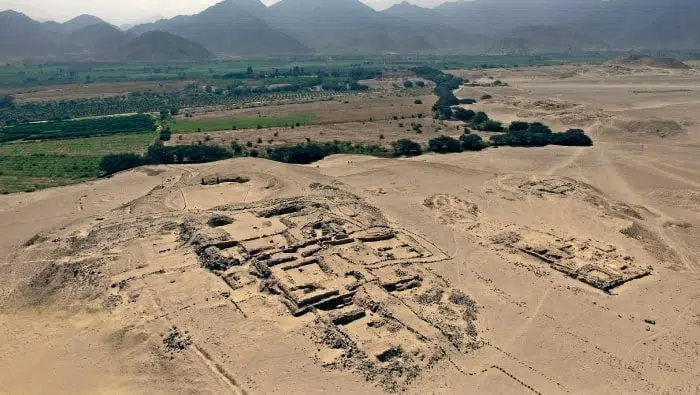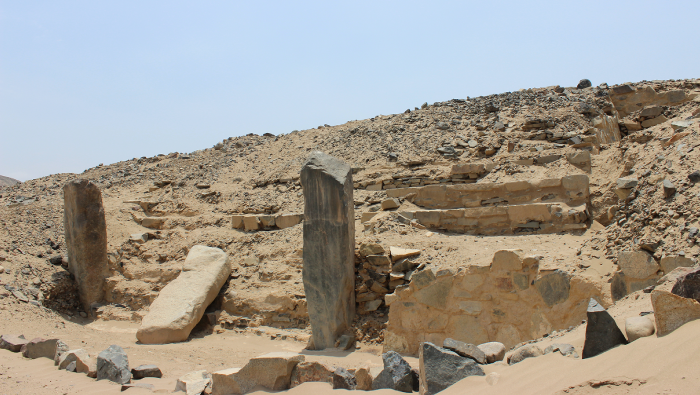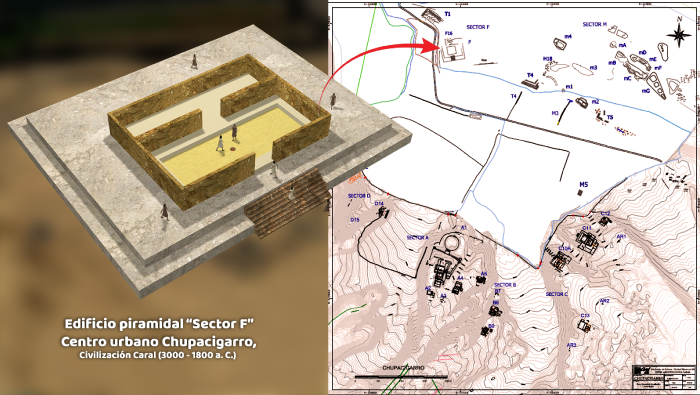A groundbreaking discovery in Chupacigarro, Peru, has revealed an ancient pyramidal structure belonging to the Caral civilization—one of the oldest in the Americas. This significant find, located just one kilometer west of the UNESCO-listed Sacred City of Caral-Supe, provides deeper insight into the sophisticated architectural and social advancements of this ancient society.
Discovery of a Hidden Pyramid
A team of researchers from the Caral Archaeological Zone, led by Dr. Ruth Shady, uncovered the pyramid within "Sector F" of the Chupacigarro site. Previously concealed by dense vegetation, the structure was revealed to have stone walls featuring three layered platforms. At each corner, large vertical stones known as huancas mark the building’s boundaries, serving both structural and ceremonial purposes.
In the walls, archaeologists discovered large rocks that had been placed vertically, which they have named “huancas”. Credit: Zona Arqueológica Caral
The pyramid is quadrangular in shape, with a central staircase leading to its peak. This suggests that the site played a significant ritual role in Caral society. Surrounding the pyramid are 12 other public and ceremonial structures, arranged on small hills overlooking a communal plaza. Additionally, residential areas were found on the outskirts, indicating a small urban settlement spanning approximately 38.59 hectares.
Significance of the Caral Civilization
The Caral civilization, which flourished between 3000 and 1800 B.C., is renowned for its advanced architectural, agricultural, and social developments. Unlike many ancient societies, Caral lacked a written language, yet it maintained a highly structured society with an extensive trade network and monumental constructions. The city’s large pyramids, public plazas, and residential zones highlight the complexity of this early Andean civilization.
The newly uncovered pyramid in Chupacigarro is part of a broader network of Caral-era architectural sites scattered throughout the Supe Valley. Archaeologists believe these settlements played a crucial role in regional trade, culture, and religious practices.
A Geoglyph with Symbolic Importance
Among the most remarkable discoveries at Chupacigarro is a geoglyph depicting a profile head in the Sechín style—an artistic tradition from coastal Peru. This geoglyph is only visible from a specific angle, emphasizing its symbolic significance. Experts believe it suggests a cultural and ceremonial connection between Chupacigarro, the Sacred City of Caral, and nearby coastal populations.
The presence of the geoglyph, along with the pyramid and surrounding structures, points to Chupacigarro as a center for both ritual and economic activities. Its strategic location provided access to marine and agricultural resources, which were essential for sustaining the region’s ancient communities.
Ongoing Research and Mapping Efforts
Archaeologists excavating the Chupacigarro archaeological site discovered a previously unknown quadrangular pyramidal structure, designated as Sector F, covering an area of 38.59 hectares. Credit: Zona Arqueológica Caral
Following this discovery, Dr. Shady’s team is undertaking a comprehensive mapping project to fully understand the site’s extent and significance. The findings at Chupacigarro contribute to a growing body of research that continues to reshape our understanding of early civilizations in the Americas.
This latest discovery reinforces the Caral civilization’s legacy as one of the world’s earliest and most sophisticated cultures, leaving an enduring mark on the history of human development.









